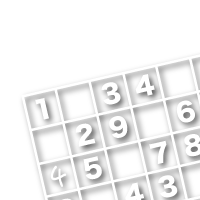

Sponsored Links
TOP > Column > The number of Sudoku combinations
The number of Sudoku combinations
Combination of numbers
How many combinations are there in Sudoku? I thought I could solve this using math I learned in high school, but it’s quite difficult.
The first column is easy, 9*8*7*6*5*4*3*2*1 yields 362880 combinations.
The second column ABC excludes ABC from the first column, so 6*5*4 yields 120.
The third column ABC is 3*2*1, which yields 6.
Up until here, it’s pretty easy, but from the DEF on the second column, we must exclude the DEF on the first column and ABC in the second column.
If the DEF and ABC in the first and second column respectively do not overlap, it is 3*2*1, but it does, so I need to use the opposite combination. But I forgot how to do this, so I’m not sure.
On the 2nd BOX it gets even harder. We have to consider all the numbers in the top row, side row, and the boxes.
It was too hard and I couldn’t solve it, so I looked it up. It seems like there are 6,670,903,752,021,072,936,960 combinations.
This includes symmetrical ones with the same numbers, so if we exclude ones that are rotated 90, 180, or 270 degrees, we get 5,472,730,538 combinations. This figure is based on claims by Mr. Ed Russell and Mr. Frazer.
Jarvis, Frazer; Ed Russell (September 7th 2005). “There are 5472730538 essentially different Sudoku grids ... and the Sudoku symmetry group”. Frazer Jarvis's home page. Posted September 16th 2006
Sponsored Links
Combination of clue boxes
We just looked at the combinations of numbers, but in Sudoku the combinations of blank boxes also come into play. If we only have 1 blank box, 9*9 yields 81 combinations. With 2 blanks, 81*80 yields 6480 boxes. But we have to remember overlaps as well. With 30 clue boxes, we need to use n factorial, which yields some ridiculously big number. Furthermore, the minimum amount of a clue box is 16, but it has to be solvable for it to be a Sudoku, so we must consider the combination of clue boxes, then create a combination with the 5472730538 number combination above, and see if it can be solved.
You might think we need to exclude combinations that are rotated by 90, 180, or 270 degrees, or symmetrical ones, just like we did with the numbers. But for every numerical combination, if we rotate the blanks by 90, 180, or 270, it becomes a completely different problem, so we don’t need to consider this.
So, it seems like the combinations are infinite in amount. I don’t think I can come up with a final figure, so let’s hope that someone else will figure it out.
Sponsored Links

